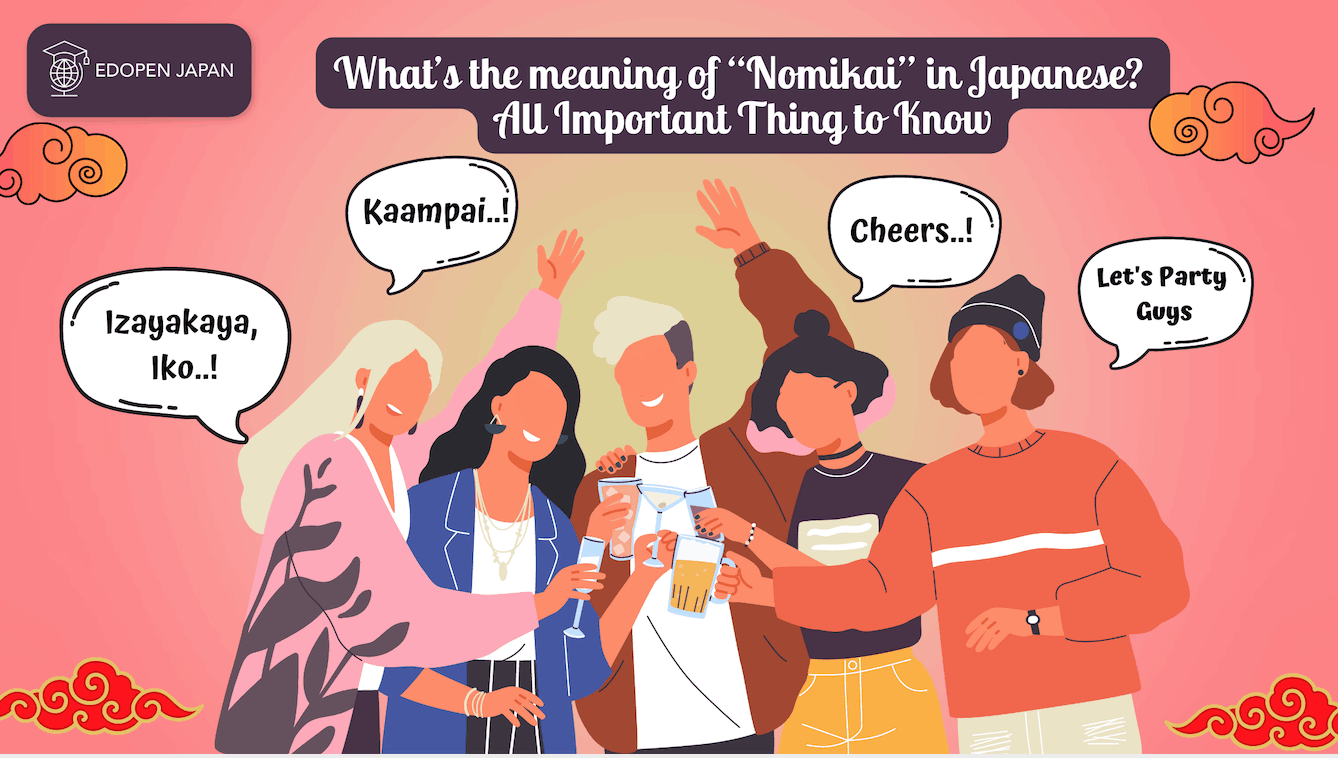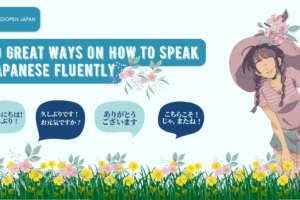Alcohol is one of the most effective social lubricants, and this is also true in professional situations and relationships. Nowadays, nomikai or drinking parties are held anywhere and anytime, including online or at someone’s home. However, a typical nomikai venue is an izakaya (Japanese-style pub).
When you come to Japan, you will eventually invite your friends, colleagues, customers, or suppliers to Nomikai. Nomikai is an integral part of working life in Japan, and is used within and between companies, schools, and governments for this and many other reasons.
Most people in Japan attend “Nomikai” and can attest to the value added to their professional lives in this extracurricular form of bonding with coworkers. This is a basic overview of Japan’s “Nomikai” drinking culture!
In addition, if you are currently studying Japanese language and phrases commonly used in everyday Japanese conversation. Here’s an example of how to introduce yourself in Japanese that you can use during Nomikai! Please also read our recommendations for studying Japanese language and culture below:
Read also:
What’s the Beautiful Meaning of Gochisousama?
What is the meaning of “kudasai (ください)”?
How to Count Money in Japanese?
Contents
What does “nomikai” mean in Japanese?
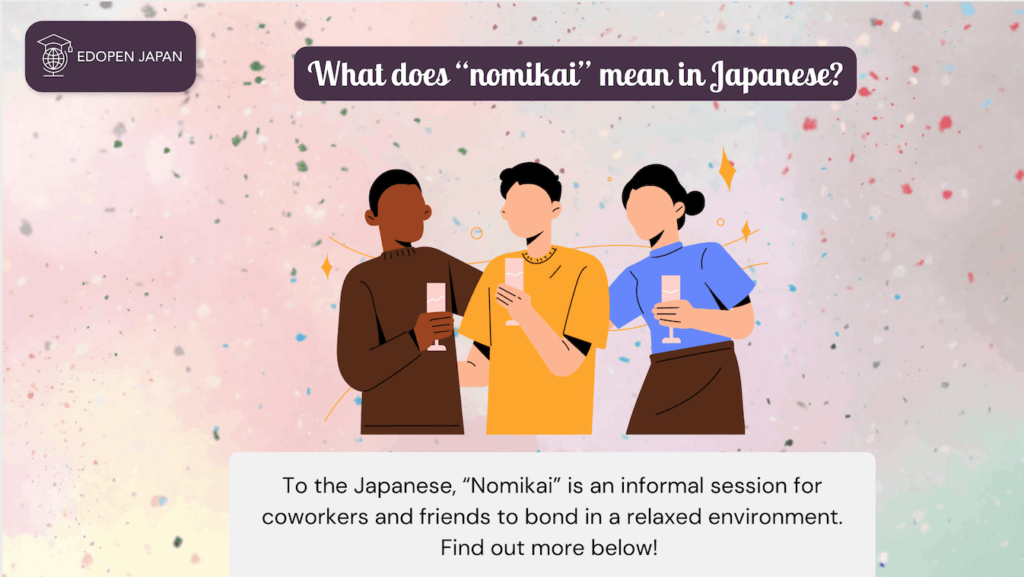
“Nomikai” is a drinking party and usually a group of friends, but often co-workers as well. It’s often meant to “improve communication” among co-workers. But many feel burdened and obligated to attend.
For the Japanese, nomikai is an informal gathering of co-workers and friends to bond in a relaxed environment. After drinking, people are generally less reserved, and this encourages even the shyest of the crowd to become more sociable. More common in the workplace, nomikai aims to promote relationship-building among employees, especially between bosses and employees.
Nomikai” is also held among members of the same team or department. Attendance is voluntary, but depending on the occasion, attendance may be strongly encouraged. Typically, the event lasts 2-3 hours and often includes a “nomihodai” (飲み放題, all-you-can-drink plan) and a set menu of dishes that everyone can share. The cost of all this fun is usually around 3500-4000 yen per person.
“Nomikai” is a chance to bond with your colleagues, to talk about things other than work, and after the first few glasses, you will see how everyone becomes more open, expressing their opinions in a straightforward way that may surprise you.
The Japanese drinking culture
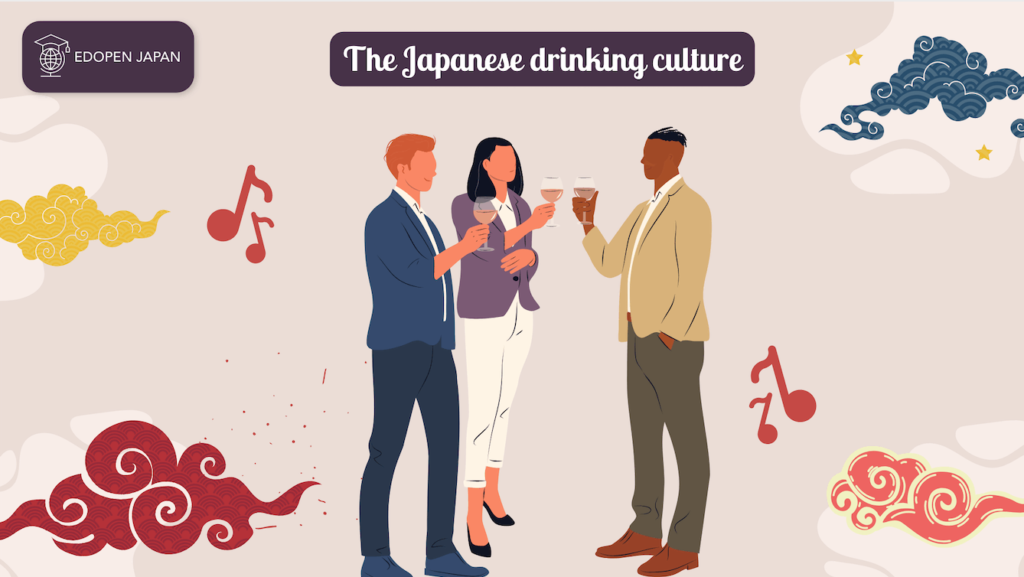
Many Japanese believe that after-work drinking parties are an important way to improve relationships. Since people have to switch between “honne” [real intention] and “tatemae” [non-real intention] every day, spending some casual time with co-workers will surely be helpful in understanding each other.
There is even a word “nomination” (combined word of 飲む/drink and communication), which is a way to build good relationships with co-workers and bosses by drinking together.
When lifetime employment was the standard in Japan, workers would say, “You have to do nomination if you want to work your way up the corporate ladder. Many older generations worked and built relationships that way. But times are changing. The economy is unstable, career changes are more common, and it’s easier to accommodate people’s needs.
The work environment is much more flexible than it used to be, and younger generations are more focused on their lives and prefer to spend less time with colleagues. Still, many people find that casual drinks and meals with teammates and bosses are important for developing closer relationships to build trust and share ideas and concerns about work and life.
About Japanese Society and Drinking Style
In a collectivist society like Japan, it’s important for the individual to feel connected and committed to the group, and vice versa. In the Japanese work style, which has specific rules such as sitting down immediately upon arriving at the office and keeping small talk with other employees to an absolute minimum, it is the time spent together outside of the office that helps bring the company’s employees closer together, which is why “nomikai” is so important.
While attending a drinking party is not explicitly required, it is understood that it is usually in your best interest to attend in order to build stronger bonds if you are working in a Japanese office, or to close the deal if you are doing international business with a Japanese company.
Rules & etiquette for the enjoyment of a Japanese “Nomikai“
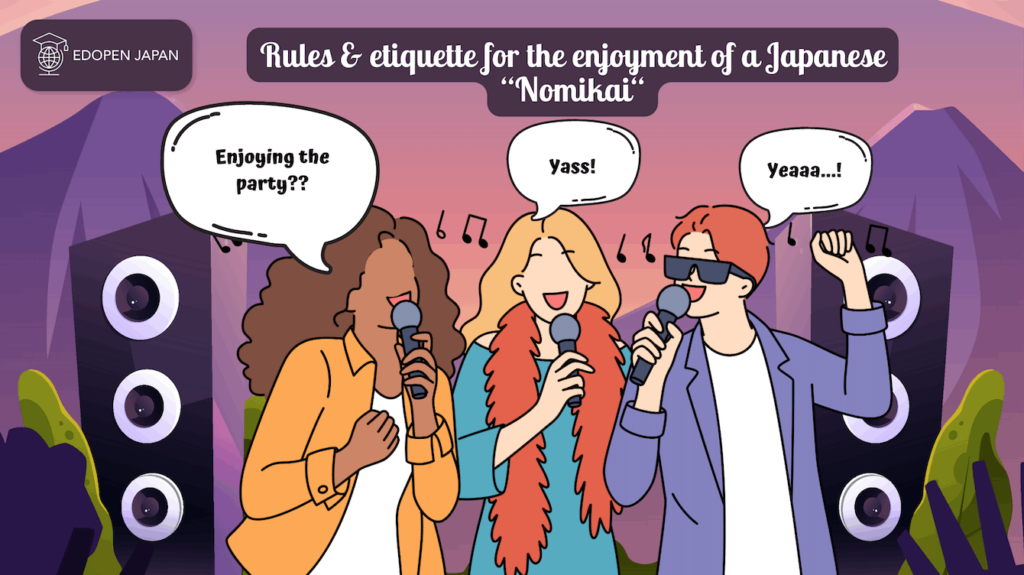
The party is usually held at an “Izakaya”. “Izakaya is a type of bar-restaurant that serves alcoholic beverages such as beer and sake and light meals called otsumami.
(1) Seating
“Nomikai” typically takes place in private rooms of restaurants and there will be an implicit seating order. It is hierarchical and the logic is the same as in meeting rooms. The boss will sit at the end of the table, on the side farthest from the door.
The second-ranking participant will sit across from him, the third will sit next to the boss, the fourth will sit across from the third, and so on.
As a newcomer, you will want to get a seat near the door. (It comes in handy if you need to excuse yourself for any reason).
(2) Opening
Once everyone and their glasses are gathered, the boss will give a speech to kick off the event. Often you will see people already clutching their glasses, eagerly awaiting the end of the speech. Keep this in mind when it is your turn to speak, and try to keep your speech short and engaging.
(3) Ordering
Once you are seated at your location, your group will order drinks. If you’re at an izakaya, the waiter will come up to you and ask for everyone’s drink orders.
The classic starting drink for nomikai is draught beer “Namabi-ru(生ビール)”. The phrase “Toriaezu Nama” (とりあえず生) is what people often say when discussing their first drink order.
After everyone gets their drink, it is time to say cheers and kanpai to the end of the year, the end of the week, or the end of the day. Of course, you can order something else if you want.
If this is your first nomikai, or if you are a foreigner invited after a job fair, and you are basically enjoying the guest treatment, you don’t have to worry about taking orders from anyone. You can show your consideration by keeping the following points in mind.
(4) Kanpai!
Different cultures and languages have different customs for starting a drink, such as “Cheers” in English, “Santé” in French.
After the last words of the speech have died down, everyone rises for the communal kampai. In Japan, you don’t pour your first drink yourself. It’s important to wait for someone else to fill the glass. Then, wait until everyone has a drink and start drinking with a “Cheers!” before putting your mouth in the glass.
You want to make sure that when you clink glasses, the rim of your glass is slightly lower than that of your elders. These trivial manners are the first step in building a better relationship as a sign of respect for the other person. After taking a sip, put the glass down to free your hands for a round of applause. After the official start of the party, drink at your own pace.
(5) Eating
Before kanpai, no one will touch any of the food on the table. Even after the first drink, you will see that people are hesitant and wait for the boss to start eating before they join in.
One thing you can do is offer to fill your coworkers’ plates, perhaps start by passing out the salad. If you do, make sure everyone gets a fair share of the toppings. If one poor guy is left with only green leaves while the guy next to him is enjoying his with tomato and shrimp, you may have dampened his mood, even if he doesn’t say so.
(6) Drinking (Nomikai)
The Rule in Nomikai
The most important rule in nomikai is to fill the glasses of those around you. Even if you forget everything else, remember this and you will have a solid foundation. In Japan, it is customary to pour each other’s drinks.
Usually the lower-ranking person does most of the pouring, subordinates for their bosses, traditionally wives for their husbands, etc. It shows respect by doing something nice for each other.
The way to pour
If you notice that your neighbor’s glass is running low, offer to order or pour them another drink. Refilling someone’s drink is called “oshaku (御酌)” in Japanese. You can just say “Ikagadesuka? (いかがですか)” while pointing to the glass or bottle. When pouring, place your left hand on the top of the bottle, your right hand on the bottom for support, and make sure the label of the bottle is facing up.
(7) How to refill a glass of beer
When you receive the glass of beer
When someone pours you a drink, hold your glass with both hands, one at the side and one at the bottom of the glass. It’s rude to leave it on the table while someone else is doing you a favor. Be sure to express your appreciation with an “Arigatougozaimasu ありがとうございます” or “Itadakimasu いただきます”.
When refusing to pour beer
Had too much to drink or just don’t feel like drinking? It is perfectly fine to refuse a drink and switch to a soft drink. If someone is taking your order or asking you what you want, just be honest about what you would like to drink.
(8) Engaging in Nomikai
“Nomikai” is the Japanese safe space to let go of the usual rules, and many take advantage of this opportunity to speak more openly, joke, or criticize in ways that didn’t seem possible during office hours. Whether it’s with the person next to you, in a small group, or across the table, it’s time to dive in, enjoy the event, and get to know the other participants better.
The Important Note:
Don’t get too drunk.
Don’t get too casual.
Don’t reveal too much
Don’t badmouth or gossip of other people.
Don’t look bored.
Try to stay aware and pay attention to other people’s reactions to you; this is the quickest way to get a sense of what’s okay and what’s not in the group.
(9) How to pay in Nomikai
“Nomikai” where the boss pays the whole bill have certainly received some attention, but it would be dangerous to take this for granted. Assuming you have to pay your share, if you end up paying less or nothing, consider yourself lucky. One person will be responsible for paying and collecting the money. If there is no announcement at the end of the event, approach them directly to find out the cost of your share.
It is almost unheard of in Japan for people to pay for their own drinks, even if they are drinking with friends. Food is often shared anyway, and since it’s a communal event, it’s customary to split the bill equally. This practice is called “Warikan割り勘 (わりかん)”.
(10) The clapping of hands in Nomikai
At the end of the event, someone might say a few words again, thanking everyone for attending, saying something about what’s next at work, and so on. This whole event is often concluded with a ceremonial clap. While the idea of a clapping ritual may seem strange at first, in Japan it is used to signify that something has come to a good end.
There are several versions, varying in formality and by region, but there is one that is widespread throughout Japan, the single clap “Ippon-Jime一本締め (いっぽんじめ)”. Standing with your hands raised in the air, silently waiting for someone to give the signal for everyone to clap their hands once at the same time. After a split second of silence, the serene atmosphere of the moment still lingering will be taken over by tumultuous thank yous, goodbyes.
(11) Learn about 二次会 (Nijikai)
At the end of the event, someone may start inviting you to a “Nijikai (二次会)”, the after party. The after party, so to speak. Attendance is voluntary, and the number of members will dwindle. This is the time for karaoke, girl bars, and other entertainment venues.
The best tips you need to know about Nomikai
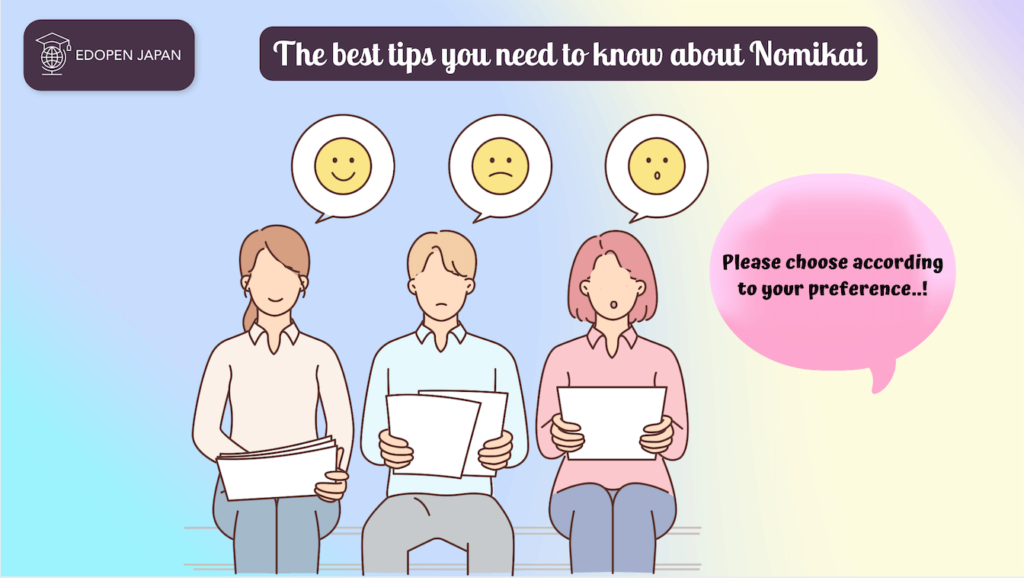
Like many Japanese customs, Japanese drinking culture has rules and expectations. As with many things in Japan, or indeed when traveling in any country. Here are some tips you need to be aware of. Please check them out!
(1) Don’t pour your own drink
If you are at a party, always pour for the people around you and wait for them to return the favor by pouring for you. While there is no hierarchy with friends, if you are out with coworkers, you are expected to pour for your boss.
(2) Don’t drink before everyone is served
Similar to the expectation that you wouldn’t start your meal until everyone has been served, it’s the same with drinks. Make sure everyone has something in their glass before you down your highball.
(3) Same order as the first round
Not as common as the others, but it makes life a lot easier for the waiters. People often order the same drink for the first round of orders, and it’s often beer. We guarantee you won’t regret it in the height of summer.
(4) Don’t drink from the bottle
This is an important point to remember, especially for those from the UK, USA or Australia. As you know, portion sizes are different in Japan, especially for beer, and sharing is very common for both food and drink. Drinking straight from the bottle doesn’t really fit in with the sharing culture, even if it’s just for you. If you’re sharing, it’s even worse and not very hygienic.
(5) Kanpai etiquette!
Wherever you travel in the world, you probably toast before you drink, and Japan is no different. Before you take that first refreshing sip, remember to say kanpai! [かんぱい] as you clink glasses with your friends and colleagues. Don’t be afraid to stand up and reach over to make sure you reach everyone. Sometimes people like to throw in their own local sayings for kanpai or cheers.
How was it? There are some rules and etiquette in Japanese “Nomikai”, but please do not take it too seriously, if you have never been to “Nomikai”, you should go there and experience a lot of things. First of all, let’s go out and join some “nomikai”! I’m sure everyone will welcome you and talk to you. You will make a lot of friends and have a nice moment in “Nomikai”! Enjoy yourself!
Summary
- “Nomikai” are a chance to bond with colleagues, to talk about things other than work, the Japanese safe space to let go of the usual rules, with many taking the opportunity to speak more openly, to joke or criticize in ways that didn’t seem possible during office hours.
- While attending a “nomikai” is not explicitly required, it is understood that it is usually in your best interest to attend in order to form stronger bonds.
- It is customary in Japan to pour each other’s drinks. Usually the lower-ranking person does most of the pouring, subordinates for their bosses, traditionally wives for their husbands, etc. It shows respect by doing something nice for each other.
- When you clink glasses, the rim of your glass is slightly lower than that of your boss. These trivial manners are the first step in building a better relationship because they show respect for the other person.
- Before the kanpai, no one touches the food on the table.
Then, let’s go out and join some “nomikai” and experience a lot of Japanese cultures!

